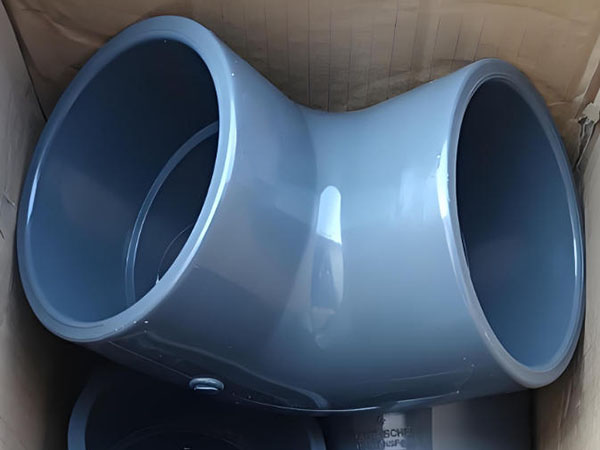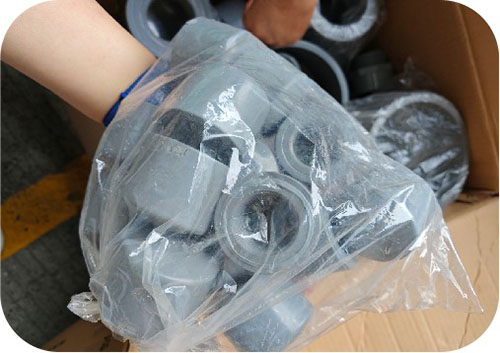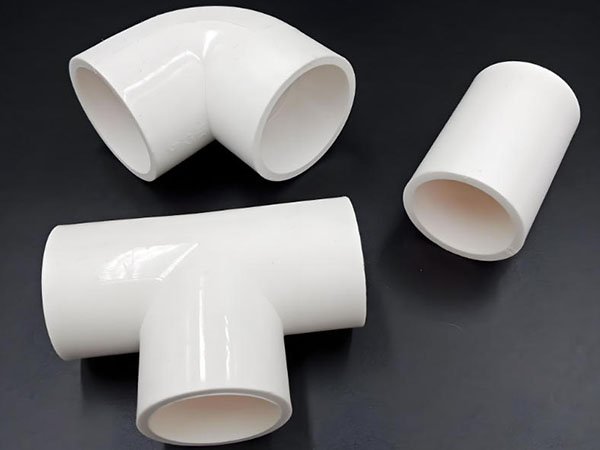In modern industrial fluid transport, the reliability, safety, and durability of piping systems are paramount. Among numerous material options, SCH 80 CPVC fittings, with their unique combination of properties, have become a preferred solution for corrosive fluid handling systems. This article will provide a comprehensive introduction to the product features, core advantages, wide applications, and installation tips of SCH 80 CPVC fittings.

What are SCH 80 CPVC fittings?
To understand SCH 80 CPVC fittings, we first need to understand the composition of their name:
CPVC (Chlorinated Polyvinyl Chloride): CPVC is a high-performance variant of PVC (polyvinyl chloride). Through an additional chlorination process, the chlorine content in CPVC is significantly increased. This change in chemical structure gives CPVC superior properties over PVC:
Higher Heat Resistance: CPVC can withstand continuous operating temperatures exceeding 90°C, and even withstand short-term temperatures exceeding 100°C, while PVC is typically limited to temperatures below 60°C. Excellent Corrosion Resistance: CPVC offers excellent resistance to a wide range of corrosive chemicals, including acids, bases, and salts, making it ideal for industrial applications.
Enhanced Mechanical Strength: A higher chlorine content provides greater hardness and strength.
SCH 80 (Schedule 80): This is a pipe wall thickness grade under the North American standard system. SCH 80 designates pipes and fittings with thicker walls, enabling them to withstand higher internal pressures and greater mechanical impact. Compared to the more common SCH 40, SCH 80 CPVC offers a higher pressure rating and greater structural integrity.
Thus, SCH 80 CPVC fittings represent the “heavy-duty” range of CPVC materials, designed for demanding high-pressure, high-temperature, or highly corrosive applications.
Core Advantages and Product Features of SCH 80 CPVC Fittings
1. Excellent Corrosion Resistance
This is CPVC’s most significant advantage. It resists a wide range of industrial chemicals, including highly corrosive media such as hydrochloric acid, sulfuric acid, nitric acid, and sodium hydroxide (caustic soda), eliminating the pitting, rust, and scaling common to metal pipes. This means longer system life, lower maintenance costs, and guaranteed fluid purity.
2. High Heat Resistance and High Pressure Rating
SCH 80’s thick-wall design enables it to maintain high pressure ratings at higher temperatures. For example, at room temperature (23°C), SCH 80 CPVC piping systems can safely withstand working pressures up to 150 psi (approximately 1.03 MPa) or even higher. As temperatures rise, its pressure retention far exceeds that of other plastic pipes. This makes it an ideal choice for conveying hot water and warm chemical fluids.
3. Excellent Flame Retardancy
CPVC is inherently flame retardant, with a Limiting Oxygen Index (LOI) greater than 60, meaning it is difficult to burn in air and will self-extinguish even when removed from a flame source. This characteristic is particularly important in industrial environments involving flammable chemicals or where fire protection is crucial.
4. Smooth Inner Surface, Low Fluid Resistance
CPVC pipe fittings have an exceptionally smooth inner surface with a very low coefficient of friction, effectively reducing pressure loss during fluid transportation and improving efficiency. Furthermore, the smooth surface is less susceptible to bacterial growth and dirt accumulation, making it easy to clean.
5. Easy Installation, Cost-Effective
CPVC pipe fittings are typically connected using solvent-based adhesives, making installation simple and quick, eliminating the complex and dangerous processes required for metal pipes, such as welding and threading. This significantly reduces labor costs and installation time. Furthermore, CPVC’s lightweight material makes handling and installation much easier.
6. Long Service Life and Low Maintenance
Properly designed and installed, SCH 80 CPVC piping systems offer an extremely long service life, providing decades of reliable operation. Its corrosion resistance virtually eliminates the need to replace corroded pipes, resulting in outstanding cost-effectiveness throughout the entire lifecycle.

Main Product Types and Applications
SCH 80 CPVC fittings offer a comprehensive range of fittings, covering nearly all pipe connection needs. Common types include:
Elbows: 90° and 45°, used to change pipe direction.
Tees: Equal and reducing tees, used to divide or merge flow.
Couplings: Used to connect two straight pipe sections.
Reducers: Used to connect pipes of different diameters.
Caps: Used to seal pipe ends.
Unions: Facilitate system disassembly and maintenance.
Flanges and flange adapters: Used to connect to other equipment (such as pumps, valves, and tanks).
Applications are extensive, including:
Industrial process piping: Used to transport corrosive chemicals in industries such as the chemical, petrochemical, electroplating, semiconductor, papermaking, and pharmaceutical industries.
Hot water distribution systems: Suitable for hot water supply pipes in commercial buildings, hospitals, and schools. Fire sprinkler systems: CPVC fire protection piping is an excellent alternative to metal piping, particularly in corrosive environments or where water damage and rust must be avoided.
Drinking water treatment plants: CPVC is used to transport treated water containing chlorine, as it offers excellent chlorine resistance.
Mining: It is used to transport acidic water and other chemical solutions underground in mines.
Installation Precautions and Selection Guide
1. Proper Installation Techniques
Cutting: Use a dedicated cutter or saw to ensure the cut is flush and perpendicular to the pipe axis.
Deburring: Thoroughly remove burrs from the inside and outside of the cut, and chamfer appropriately.
Cleaning: Use a dedicated CPVC cleaner to thoroughly remove oil, dirt, and dust from the socket and spigot surfaces.
Gluing: Evenly apply a dedicated CPVC solvent-based adhesive to the inside of the fitting socket and the outside of the pipe spigot.
Connecting: Quickly insert the pipe into the fitting socket and rotate it a quarter turn to ensure even distribution of the adhesive. Maintain pressure for a short period of time to allow for initial curing.
Curing Time: The manufacturer’s recommended curing time must be adhered to. Do not pressure test the system until it reaches full strength.
2. System Design and Selection
Thermal Expansion Compensation: CPVC has a high coefficient of thermal expansion. When designing long-distance piping, consider installing expansion joints or using elbows for natural expansion compensation.
Supports and Hangers: Install pipe supports according to specifications, with spacing closer than that of metal pipes to prevent sagging and stress concentration.
Pressure/Temperature Derating: Always refer to the manufacturer’s pressure-temperature derating table to ensure that the system’s design pressure remains within a safe range at the maximum operating temperature.
Chemical Compatibility: While CPVC is widely resistant to corrosion, its compatibility with specific chemical fluids must be confirmed before use.

Comparison with Metal and Other Plastic Pipe Fittings
1. Stainless Steel/Carbon Steel: CPVC offers significant advantages in chemical resistance, lower cost, lighter weight, and rust resistance. However, metal remains an irreplaceable option in applications involving extremely high temperatures or severe mechanical impact.
2. PP/PPH: Polypropylene generally has lower temperature resistance than CPVC, and SCH 80 CPVC has a higher pressure rating. CPVC also offers greater rigidity.
3. PVDF: PVDF offers superior temperature and chemical resistance, but also costs significantly more than CPVC. CPVC offers significant cost-effectiveness and is suitable for most applications with moderate corrosion and temperature requirements.
SCH 80 CPVC fittings are a remarkable achievement in modern industrial piping technology, offering a perfect balance of superior chemical resistance, high pressure and heat resistance, flame retardancy, and economical installation. Whether used in demanding industrial processes or hot water systems in commercial buildings, they provide a reliable, durable, and efficient connection solution. By selecting the appropriate SCH 80 CPVC fittings and following the correct installation instructions, you will be able to build a durable, reliable, high-performance piping system that will provide long-term value to your project.






















